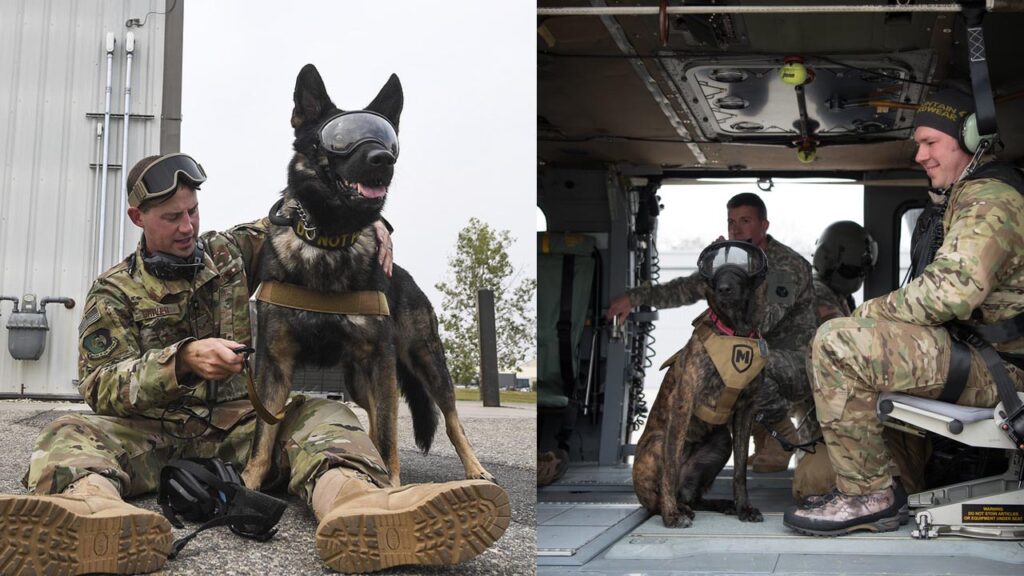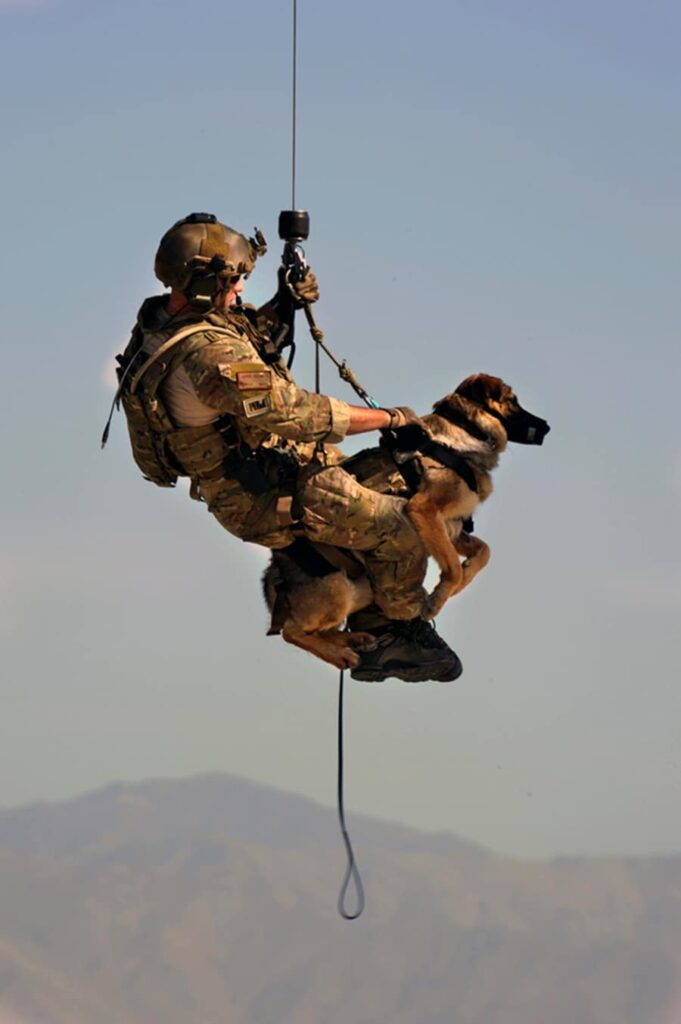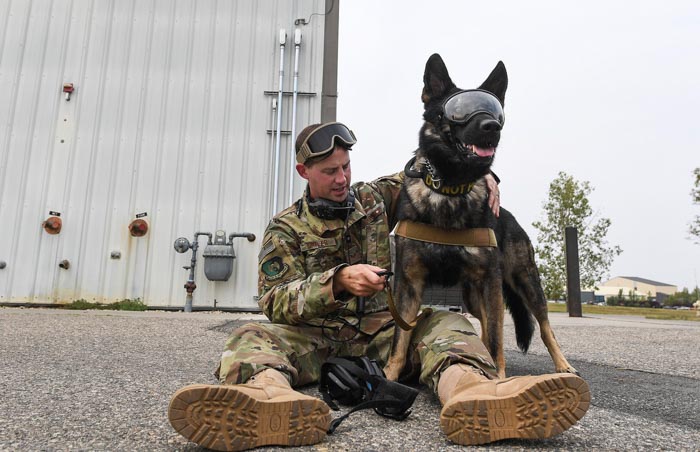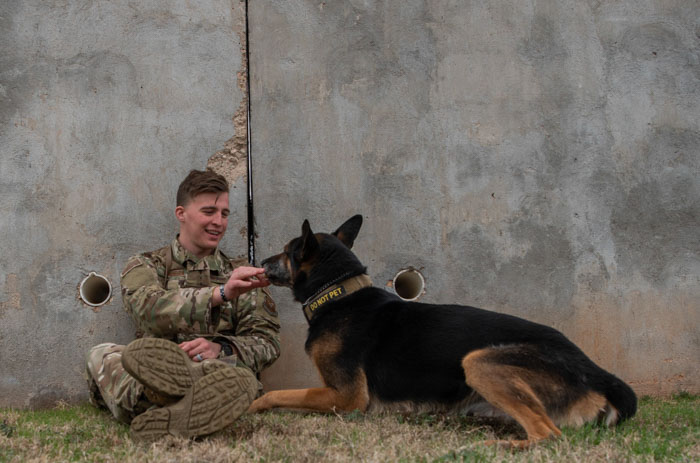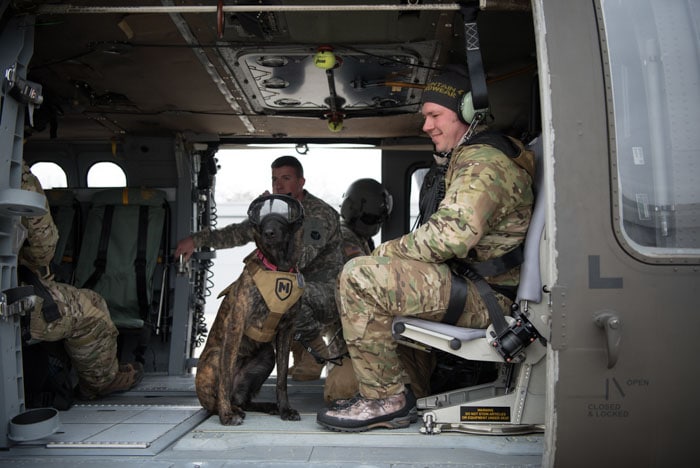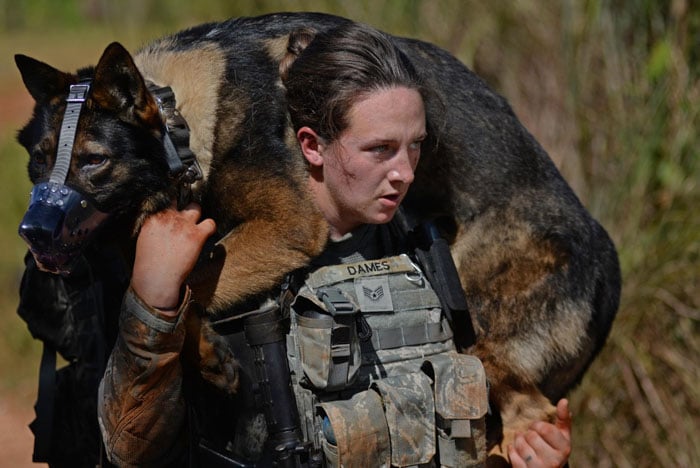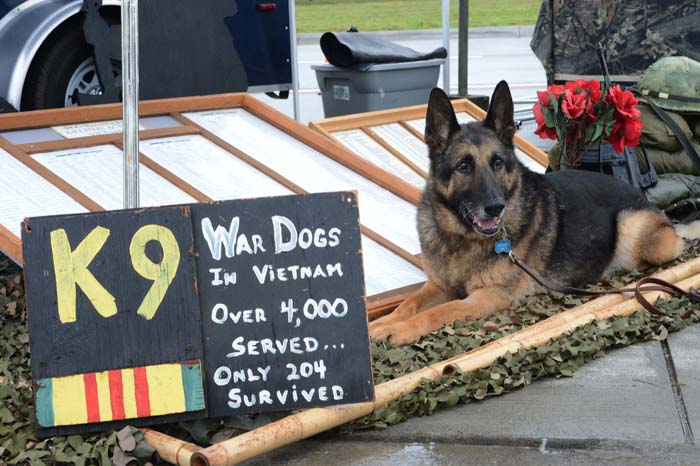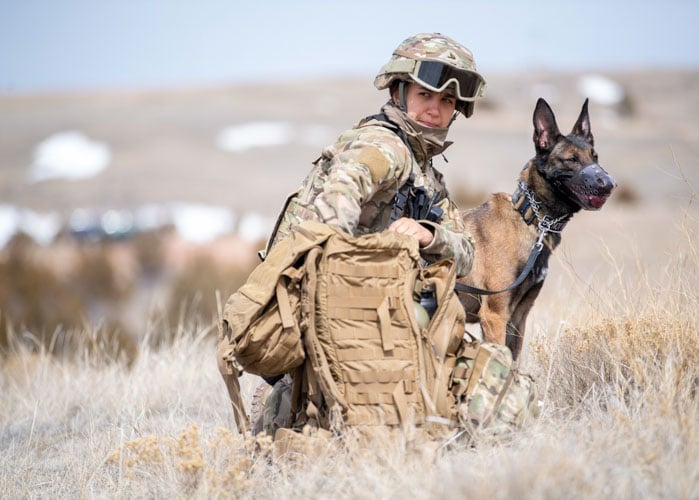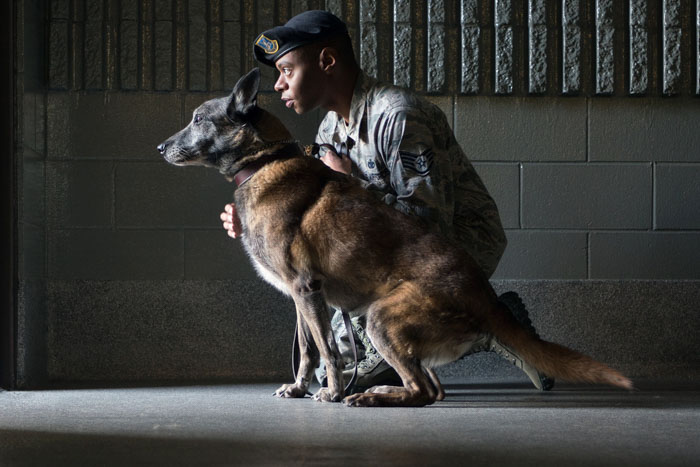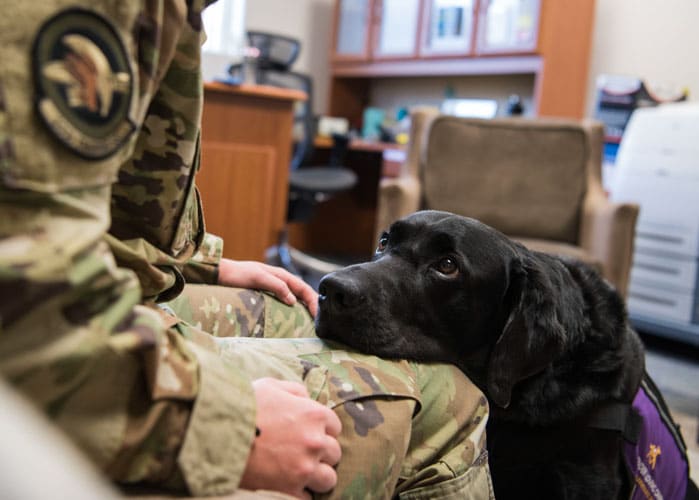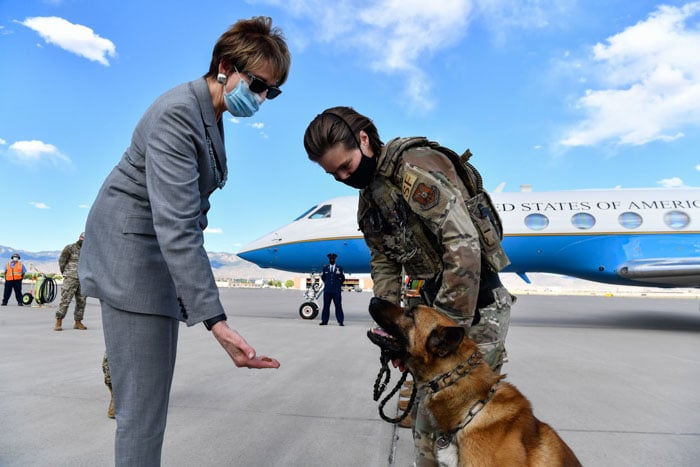Military dogs are among the bravest dogs in the world. They are originally bred to work and hunt.
They are considered among the most hardworking, discipline, and most robust breeds in the world.
Do you want to know more about military dogs? The following are the ten things that you may not know about military dogs.
Military dogs are trained in detecting bombs, weapons, and drug police dogs and are trained in searching for dangerous subjects such as weapons, drugs, and bombs detection.
With the help of rigorous training, they can be the best partner for investigation.
They can fully detect drugs, bombs as well as weapons efficiently compared to other military equipment.
1. Military dogs believe in magic.
Source – af.mil Staff Sgt. Timothy Driver, 5th Security Forces Squadron military working dog handler, adjusts safety equipment for Deny, 5th SFS MWD, during flight familiarization training at Minot Air Force Base, N.D., Aug. 23, 2018. This was the first time the K-9 unit has flown with the 54th Helicopter Squadron. (U.S. Air Force photo by Senior Airman Jonathan McElderry)
These dogs believe in magic. They can determine the difference between a smelling rock and an explosive bomb.
As they found the object, they display the change in behavior like tilting the heard, wagging, or stopping.
Then, the trainer can throw a ball that can cheer the dog for his achievement.
2. They can be the ultimate anthropologists.
Source – af.mil Senior Airman Michael Madeira, 7th Security Forces Squadron military working dog handler, and MWD Fix, take a break at Dyess Air Force Base, Texas, Jan. 21, 2020. MWDs have a diet designed for their strict training regimen, but treats are authorized. (U.S. Air Force photo by Senior Airman River Bruce)
You may not know it, but military dogs are ultimate anthropologists. They can observe and study the people around them.
They can also predict us and know if we are having a bad day. Dogs with extensive training can also provide you therapy.
They can hang out with you if they observe that you feel sad and down.
3. Like humans, military dogs can also experience post-traumatic stress disorder.
Source – af.mil Tech. Sgt. Rudy Parsons, 123rd Special Tactics pararescueman, and his search and rescue dog, Callie, ride a UH-60 Black Hawk aircraft as part of Callie’s familiarization training at the Boone National Guard Center, Frankfort, Ky., Nov. 29, 2018. Callie is currently the only search and rescue dog in the Department of Defense. (U.S. Air National Guard photo by Staff Sgt. Joshua Horton)
PTSD or post-traumatic stress disorder is one of the common issues in soldiers.
Well, it can also happen to military dogs. If the dog begins to suffer from PTSD, it can affect his ability as a military dog.
He can be released from service if he can’t perform his duties. Then, he can be offered for adoption.
4. Different breeds can serve as military dogs.
Source – af.mil U.S. Air Force Staff Sgt. Victoria Dames, a 35th Security Forces Squadron military working dog handler, carries MWD Elvis during the second annual Security Forces Advanced Combat Skills Assessment at Andersen Air Force Base, Guam, June 6, 2017. The Defenders Challenge provided Airmen with invaluable interaction with other security forces members by exchanging tactics and skills between those in attendance. (U.S. Air Force photo by Airman 1st Class Gerald R. Willis)
Among the most common dogs for military service are German shepherds. However, other dog breeds can also be useful for military service.
Dog breeds that are intelligent and trainable are qualified to be military dogs.
Some of these breeds are Belgian Malinois and Labrador Retrievers.
5. Only 50% can make it through with the rigorous training process.
Source – af.mil Luke, a retired military working dog, sits at the United States War Dogs Association display at the 2016 Shaw Air Expo and open house, “Thunder Over the Midlands,” at Shaw Air Force Base, S.C., May 21, 2016.
Being a military dog comes with tough requirements. The dog needs to be healthy, intelligent and has the willingness to learn.
The dog also needs to be responsive to commands. Dog breeds with physical health problems such as hip dysplasia are not qualified to be a military dog.
Another important trait for potential candidates for military service is the dog’s motivation for rewards.
The rewards that are used in training are Kong toys. It is helpful to encourage the motivation of the dog when it comes to the training.
6. Not all military dogs are big, strong warriors.
Source – af.mil Staff Sgt. Lindsay Zaccardi, 823nd Base Defense Squadron military working dog handler, and JJoan, 823nd BDS MWD, dig into their pack for medical supplies during a Mission Readiness Exercise at Camp Guernsey, Wyo., March 26, 2019. The pair was patrolling an entry control point when two scenario actors approached the ECP as injured, local civilians. (U.S. Air Force photo by 1st Lt. Faith Brodkorb)
In today’s modern generation, the most common war dogs include Belgian Malinois and German shepherds.
However, friendly Labrador retrievers play as sniffer dogs in Afghanistan. It is quite unbelievable, but there are also small dogs used for military service.
One example of this is a small Jack Russell terrier.
7. Military dogs are considered as official equipment by the Defense Department.
Source – af.mil Staff Sgt. Cody Howey, 380th Security Forces Squadron military working dog handler and his K-9 partner, Eros, navigate an obstacle during a warm-up exercise to prepare Eros for patrol duty on Al Dhafra Air Base, United Arab Emirates, May 14, 2018. (U.S. Air National Guard photo by Tech. Sgt. Nieko Carzis)
Although dogs are considered as man’s best friends, the Defense Department considered the military dogs as their official equipment.
Based on the statement of Air Force Senior Master Sergeant Antonio Rodriguez, dogs are not a type of equipment, but breathing, working animal that deserves to be treated with kindness and respect.
He added that the dog is a partner and values meaningful interaction. You just not similarly consider equipment.
8. Some dogs in the military service jump from planes.
Source – af.mil Staff Sgt. Christopher Bennett, 673rd Security Forces Squadron military working dog handler, works with Kimba, a Belgian Malinois, at one of the kennels at Joint Base Elmendorf-Richardson, Alaska, Sept. 11, 2018. Kimba is approaching retirement after 10 years of military service. (U.S. Air Force photo by Justin Connaher)
Another impressive thing about military dogs is that they jump from planes. These dogs are super-high-drive and among the toughest in the world.
They are specially trained and procured by military contractors instead of the DOD’s Military Working Dog program.
Some military dogs join their partner during parachute jumps from the planes. Some rappel with their partners in helicopters.
These dogs are called multi-purpose canines (MPCs). They are used for Special Operations teams like Navy SEALs. They have crucial roles in military service.
9. Military dogs can develop close bonds with their unit.
Source – af.mil Preston, 30th Space Wing courthouse facility dog, focuses on an Airman who visited the Sexual Assault Prevention and Response office, Dec. 4, 2019, at Vandenberg Air Force Base, Calif. Preston, the Defense Department’s first certified courthouse facility dog, was trained through the POOCH, or prisoners overcoming obstacles and creating hope, program for two years. (U.S. Air Force photo by Airman 1st Class Aubree Milks)
The best about military dogs is that they can develop close bonds with their handlers, which is quite adorable.
They are trained closely by their handler. They can also bond with their unit.
They can develop a bond of trust and love with their handler. If one of the two falls in the battle, one can be devastated by the loss.
Handlers can have a touching experience with their military dogs. If you are at war, military dogs can be the best companion. They can also serve as your therapy.
There we go, that is the list of the ten things you may not know about military dogs.
With their abilities, they can help military personnel to their tasks. Meanwhile, you must also be responsible for keeping them healthy.
They need extensive training to perform their military tasks well.
10. Other Facts About Military Dogs
Source – af.mil Secretary of the Air Force Barbara Barrett offers a treat to a military working dog during a tour of Kirtland Air Force Base, N.M., May 21, 2020. Barrett toured units at Cannon, Holloman and Kirtland Air Force Bases during her three-day trip. (U.S. Air Force photo by Eric Dietrich)
- Military dogs are put down after they retire.
Military dogs are put down after they retired. However, this practice is not used anymore until 2000.
Nowadays, handlers have the option of adopting retired military dogs once it ends its service.
- Military dogs are priceless, but they have worth thousands of dollars.
Even though they are priceless when it comes to value, military dogs are highly valuable.
With the training, effort, and time to develop a police dog, their worth is about $150,000.
With their abilities like bomb detection, they are truly impressive and important.
- These dogs are involved in combat on major conflicts.
Police dogs have a complicated history. They have been used in the US combat conflict or situation. These dogs are not recognized until WWII.
- Most military dogs don’t come from the United States.
It is estimated that about 85% of military dogs don’t come from the United States. Usually, these police dogs come from the Netherlands and Germany.
Military dogs that are chosen came from long bloodlines of dog breeds. Currently, the US military is making efforts to use more USA bred and born dogs.
- Military dogs are chosen based on their love of Kong or the ball.
These dogs are chosen based on their love of Kong or the ball. If they are motivated to get a reward, they tend to work hard.
They can even save lives in combat situations.
Conclusion
To sum it up, military dogs are not just ordinary dogs. They are dog breeds that can perform military tasks to help their unit.
They can also establish good relationships with their partner or handler. Just like humans, military dogs also have emotions.
They care for their handler. They can observe whether their partner is having a bad time.
If their handler was lost in combat, they also mourn for them.
With proper training, military dogs can be the most efficient partner when it comes to performing tasks like bomb detection, searching for weapons, and more.
Military dogs are unique and impressive since they can perform military service while being a good friend to you.
All Image Credits goes to U.S. Air Force
